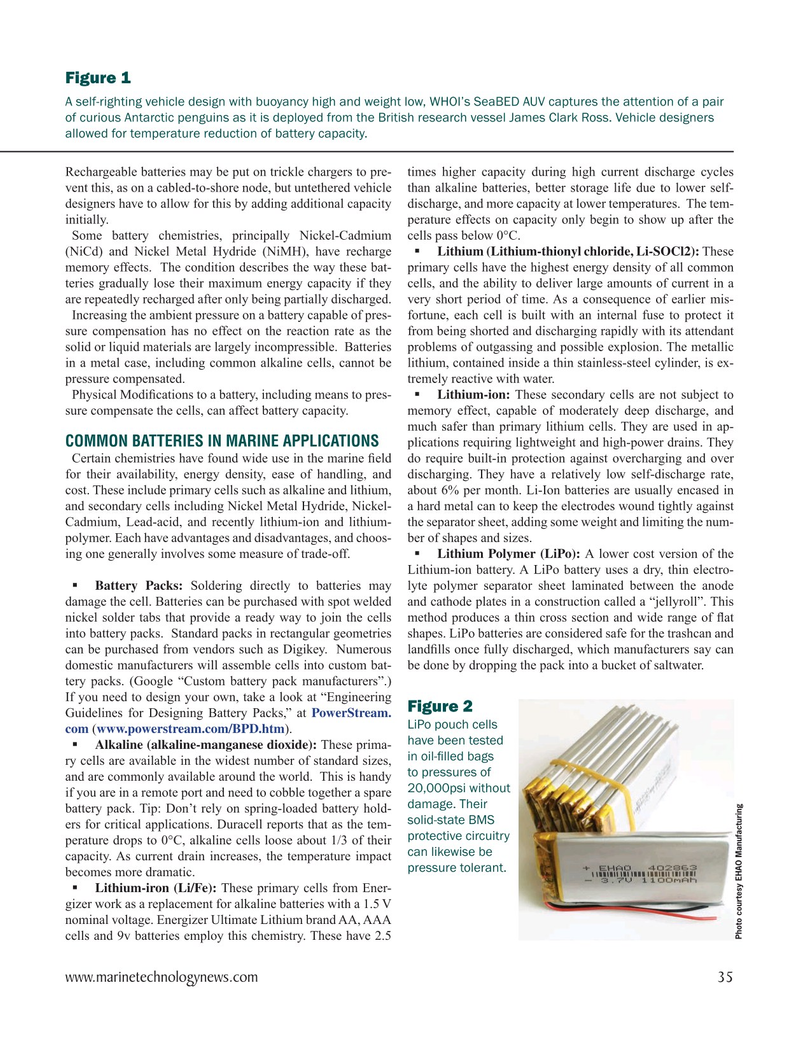
Page 35: of Marine Technology Magazine (March 2024)
Read this page in Pdf, Flash or Html5 edition of March 2024 Marine Technology Magazine
Figure 1
A self-righting vehicle design with buoyancy high and weight low, WHOI’s SeaBED AUV captures the attention of a pair of curious Antarctic penguins as it is deployed from the British research vessel James Clark Ross. Vehicle designers allowed for temperature reduction of battery capacity.
Rechargeable batteries may be put on trickle chargers to pre- times higher capacity during high current discharge cycles vent this, as on a cabled-to-shore node, but untethered vehicle than alkaline batteries, better storage life due to lower self- designers have to allow for this by adding additional capacity discharge, and more capacity at lower temperatures. The tem- initially. perature effects on capacity only begin to show up after the
Some battery chemistries, principally Nickel-Cadmium cells pass below 0°C.
(NiCd) and Nickel Metal Hydride (NiMH), have recharge ? Lithium (Lithium-thionyl chloride, Li-SOCl2): These memory effects. The condition describes the way these bat- primary cells have the highest energy density of all common teries gradually lose their maximum energy capacity if they cells, and the ability to deliver large amounts of current in a are repeatedly recharged after only being partially discharged. very short period of time. As a consequence of earlier mis-
Increasing the ambient pressure on a battery capable of pres- fortune, each cell is built with an internal fuse to protect it sure compensation has no effect on the reaction rate as the from being shorted and discharging rapidly with its attendant solid or liquid materials are largely incompressible. Batteries problems of outgassing and possible explosion. The metallic in a metal case, including common alkaline cells, cannot be lithium, contained inside a thin stainless-steel cylinder, is ex- pressure compensated. tremely reactive with water.
Physical Modi? cations to a battery, including means to pres- ? Lithium-ion: These secondary cells are not subject to sure compensate the cells, can affect battery capacity. memory effect, capable of moderately deep discharge, and much safer than primary lithium cells. They are used in ap- plications requiring lightweight and high-power drains. They
COMMON BATTERIES IN MARINE APPLICATIONS
Certain chemistries have found wide use in the marine ? eld do require built-in protection against overcharging and over for their availability, energy density, ease of handling, and discharging. They have a relatively low self-discharge rate, cost. These include primary cells such as alkaline and lithium, about 6% per month. Li-Ion batteries are usually encased in and secondary cells including Nickel Metal Hydride, Nickel- a hard metal can to keep the electrodes wound tightly against
Cadmium, Lead-acid, and recently lithium-ion and lithium- the separator sheet, adding some weight and limiting the num- polymer. Each have advantages and disadvantages, and choos- ber of shapes and sizes.
ing one generally involves some measure of trade-off. ? Lithium Polymer (LiPo): A lower cost version of the
Lithium-ion battery. A LiPo battery uses a dry, thin electro- ? Battery Packs: Soldering directly to batteries may lyte polymer separator sheet laminated between the anode damage the cell. Batteries can be purchased with spot welded and cathode plates in a construction called a “jellyroll”. This nickel solder tabs that provide a ready way to join the cells method produces a thin cross section and wide range of ? at into battery packs. Standard packs in rectangular geometries shapes. LiPo batteries are considered safe for the trashcan and can be purchased from vendors such as Digikey. Numerous land? lls once fully discharged, which manufacturers say can domestic manufacturers will assemble cells into custom bat- be done by dropping the pack into a bucket of saltwater. tery packs. (Google “Custom battery pack manufacturers”.)
If you need to design your own, take a look at “Engineering
Figure 2
Guidelines for Designing Battery Packs,” at PowerStream.
LiPo pouch cells com (www.powerstream.com/BPD.htm). have been tested ? Alkaline (alkaline-manganese dioxide): These prima- ry cells are available in the widest number of standard sizes, in oil-? lled bags and are commonly available around the world. This is handy to pressures of 20,000psi without if you are in a remote port and need to cobble together a spare damage. Their battery pack. Tip: Don’t rely on spring-loaded battery hold- solid-state BMS ers for critical applications. Duracell reports that as the tem- perature drops to 0°C, alkaline cells loose about 1/3 of their protective circuitry capacity. As current drain increases, the temperature impact can likewise be pressure tolerant. becomes more dramatic. ? Lithium-iron (Li/Fe): These primary cells from Ener- gizer work as a replacement for alkaline batteries with a 1.5 V nominal voltage. Energizer Ultimate Lithium brand AA, AAA
Photo courtesy EHAO Manufacturing cells and 9v batteries employ this chemistry. These have 2.5 www.marinetechnologynews.com 35
MTR #3 (34-47).indd 35 4/4/2024 10:46:07 AM

 34
34

 36
36
